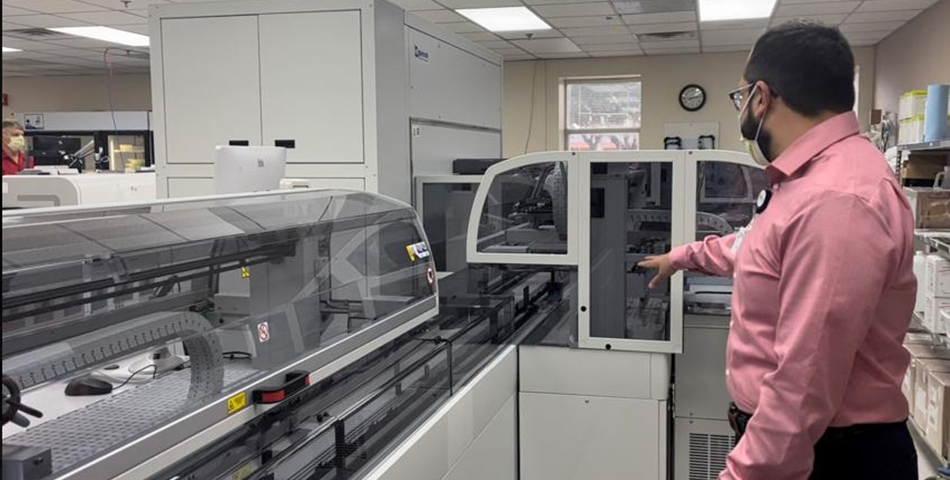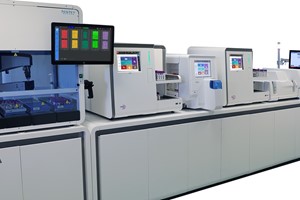Citizens Medical Center showcased new robotic laboratory equipment that is expected to cut down on testing time significantly.
The robotic equipment, titled the Abbott project, cost $1.5 million and took 18-months to plan and transition to it as it came online in late July. It was showcased at a Tuesday hospital board meeting.
The equipment, which includes a robotic track for samples along with the ability to store and test them, minimizes the potential for samples to be corrupted, Citizens Lab Director Rene Ramirez said.
It also has two centrifuges, compared to the single one in the previous system, which caused delays in the lab, Ramirez said. Additionally, the system allows lab workers to see where exactly a sample is in the testing process rather than waiting to see it complete.
“When I came to Citizens over a decade ago, I was very impressed with the amount of technology this institution has invested in the laboratory,” said Dr. Leilani Valdes, Citizen’s medical director of pathology. “That is not common, and it really does in my opinion, I know I’m slightly biased, increases patient care and makes it easier for our physicians to do their job if you have accurate, timely results.”
Valdes noted 70% of diagnoses are based on lab results, and the investment is appreciated, she said.
The system runs about 1,500 tests an hour, Ramirez said. The lab does about 200 to 300 panels a day, which can have 12 to 14 tests per panel, making the lab’s job significantly easier.
The previous system was very manual, while the new system is much more intuitive and automated, he said.
“Everything is completely automated,” Ramirez said. “Automation just means there is less error introduced.”
The average time for a test from receiving the sample to getting a result is 40 minutes, and with the new system, he expects to get that down to 30 to 34 minutes.
“Technology is vital to our success as a hospital,” CEO Mike Olson said. “We’ve got to continue to reinvest in the latest and greatest technologies that are going to allow us to meet the needs of our patients the best way possible.”
Laboratory Equipment Market Size Worth USD 85,801 Million by 2030 at 7.40% CAGR
According to a Comprehensive Research Report by Market Research Future (MRFR), “Laboratory Equipment Market Information By Product Types, Applications, End User, And Region - Forecast till 2030", the market will reach USD 85,801.35 million by 2030, at 7.40% CAGR.
Medical laboratories need various supplies to carry out tests and conduct research. These can be found in various labs, including research labs, clinical diagnostic labs, microbiology labs, and teaching labs, where they are used to conduct scientific experiments, conduct research, and perform analyses on various scientific materials. Innovative technologies, such as specialized tools, are being developed by both public and commercial research organizations in the context of research and development operations to diagnose and treat various diseases throughout the world. As a result of developments in biological and chemical research, there has been an increase in the availability of laboratory supplies. According to the sector, there is a growing need for laboratory equipment due to the growing number of clinical laboratory tests and life science research initiatives.
According to estimates, the market for laboratory equipment and disposables will expand significantly over the forecast period due to technological expansions in the field of lab equipment, an increase in the number of clinical diagnostic procedures, and increased investments in private and public healthcare. Favorable insurance policies for lab equipment also contribute to the market's expansion. Furthermore, the market for laboratory supplies and disposables is growing as a result of an increase in research in the fields of life sciences and biotechnology. Additionally, it is anticipated that buying managers in the pharmaceutical and healthcare sectors would have a higher demand for a consistent supply of essential laboratory equipment in the upcoming years.
The vital growth drivers in the laboratory equipment market are the expanding number of pharmaceutical research operations, the rising demand for correct and prompt sickness treatment, and the rising levels of private and public research funding to support scientific research operations. Several tools are needed in laboratories to carry out testing and research. General lab technology is used in research, instruction, clinical labs, quality assurance, R&D, advertising, and other applications. By enabling speedier analysis through laboratory technology, the laboratory can do more daily tests, enhancing its value. This may result in cost reductions for supplies, upkeep, paperwork related to regulations, and general expenses.
There is an increasing demand for laboratory equipment to introduce cutting-edge technologies into the market due to the rise in chronic diseases like chronic respiratory, cardiovascular, and diabetes and the incidence of lifestyle diseases like heart disease, obesity, and atherosclerosis. Favorable insurance policies for lab equipment also contribute to the market's expansion. Furthermore, the market for laboratory supplies and disposables is growing as a result of an increase in research in the fields of life sciences and biotechnology.
he high cost of cutting-edge laboratory equipment and the scarcity of clinical laboratories in some countries restrain market expansion.
Research on coronaviruses has increased as a result of the COVID-19 pandemic. The need for SARS-CoV-2 testing in clinical laboratories increased as the pandemic spread. Laboratories increased expenditures on pathology equipment due to the increased demand for these testing kits. The introduction of beneficial government programs and the rising awareness of the need for better patient care will support market expansion shortly.
However, because the main objective of the lockdown was to avoid intimate contact with others, labs conducting pre-pandemic disease research were closed down because there was little need for lab materials. Lab capabilities are expanding along with technological changes. Thanks to new technology, scientists and laboratory technicians may work more correctly and quickly than ever. Artificial intelligence, automation, miniaturization, and smart technology are advancing into the real world and simplifying lab life. The need to provide outcomes rapidly is also growing concurrently. So, laboratories need to be quick and flexible. For laboratory managers, streamlining the purchase procedure is a major strategy for boosting productivity. The lab suppliers are also simplifying the product ordering and selection processes.













